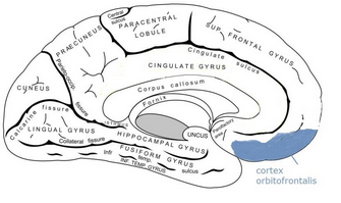Limbic system
The term limbic system is derived from the Latin word limbus which means edge. The limbic system is on the edge under the brain lobes.
The limbic system is formed by a group of brain structures in the large brain that are involved in emotion, emotion regulation, emotional memory, pleasure and motivation.
Here, hormones are produced and temperature and appetite are regulated. Damage to the limbic system can cause the hormonal system to become unbalanced. The ability to perceive hunger or a feeling of satiety is reduced and emotional reactions can change.
In the left picture below a part of the limbic system is visible. The blue part is the hippocampus, the green is the amygdala and the red the hypothalamus.
The image on the right displays another part of the limbic system that lies above the eye sockets; the cortex orbitofrontalis (the red part). (Orbita is the Latin word for eye socket).

The limbic system extends over the blue, red and green pieces on the left and the red piece on the right image.

Cortical, subcortical and diencephalon
The limbic system consists of areas that lie in the cerebral cortex (cortical areas), areas that lie under the cerebral cortex (subcortical areas) and areas of the intermediate brain (diencephalon).
The cortical areas within the limbic system are:
- Cortex orbitofrontalis
- Fornix
- Hippocampus
- Gyrus cinguli, (with the cortex cingular anterior)
- Septum pellicidum.
The subcortical areas within the limbic system are:
- Amygdala
- The nucleus accumbens.
The areas of the brain that belong to the intermediate brains, the diencephalon within the limbic system, are:
- Hypothalamus
- Corpus mammilare.
The function of these areas
The amygdala and the hippocampus together ensure the processing of emotional memories. The amygdala encodes the emotion.
The hippocampus encodes the context. That is, the people, the situations, the things and where something took place. We are more likely to remember information if we have a feeling or an emotion with it. That is in some cases very bad when someone has feared and that memory so to speak 'burned in' by the adrenaline.
The gyrus cinguli / cingulatus gyrus is a belt winding of the cerebrum (yellow in the image below) and runs like a belt (cingel) around the brainbar (corpus callosum). Spontaneous emotions plus the processing of positive and negative reinforcers (reward and punishment) are linked by researchers Bush, Luu & Posner to the front part of this area (anterior cingulate cortex; ACC).

The cortex orbitofrontal (part of the prefrontal cortex) is involved in reasoning, planning and making decisions based on information received from other brain structures (sound, taste and smell and visual information (from the secondary visual area of the sleeping lobe or temporal lobe.) According to Antonio Damasio of the University of Iowa, the cortex orbitofrontal is important for taking affective decisions.
According to Damassio people with injuries in this area often have an inability to evaluate emotional stimuli and / or make decisions based on feedback (feedback) of socio-emotionally relevant information.
If there is so much input from sensory stimuli in this part of the brain, and this part of the brain has to evaluate emotional stimuli, it is hardly surprising that in some of the people suffering overstimulation by brain damage, it has effects on the emotions. Light blue in the image below.

The septum pellucidum is located under the brainbar in the middle of the brain, between the two hemispheres. It appears to be an intermediate station between cognitive processes (cortex and hippocampus) and emotional processes (amygdala and hypothalamus). The septum pellucidum is light green in the image below.

- Dunglison, R. & Stedman, T.L. (1903). A dictionary of medical science. (23rd edition). Philadelphia/New York: Lea Brother & Co.
- Bush, G., Luu, P. & Posner, M.I. (2000). Cognitive and emotional influences in anterior cingulate cortex. Trends in Cognitive Sciences, 4: 215-222.
- Bechara, A., A.R. Damásio, H. Damásio & S.W. Anderson (1994), "Insensitivity to future consequences following damage to human prefrontal cortex", Cognition, 50, 7-12.
- Damásio, António (1999), The Feeling of What Happens — Body, Emotion and the Making of Consciousness, Vintage.
- Murat Yücel, Stephen J. Wood, Alexander Fornito, Judith Riffkin, Dennis Velakoulis, and Christos Pantelis, 2003 Sep; 28(5): 350–354. https://www.ncbi.nlm.nih.gov/pmc/articles/PMC193981/
- Image on Wikimedia